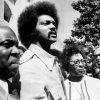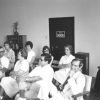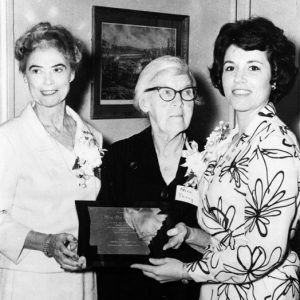calsfoundation@cals.org
Pat House (1930–2024)
Pat House played a pivotal role in organizing women in Little Rock (Pulaski County) in 1958 and 1959 to put a stop to efforts to prevent the racial integration of public schools that had been ordered by the U.S. Supreme Court. She became a force in the decades-long struggle of the schools to deal with impediments to achieving equality and also in the simultaneous struggle, after twelve years of Governor Orval E. Faubus’s leadership, to remake the state Democratic Party into a progressive institution in the era from Dale Bumpers to Bill Clinton. As a leader of the Arkansas League of Women Voters and the American Association of University Women (AAUW), she was instrumental in the successful effort to draft and ratify constitutional amendments in 1962 and 1964 to legalize voting machines and then to end the poll tax and substitute a system of lifetime registration of people to vote.
Mary Patsy (Pat) Wood was born on August 15, 1930, in Pangburn (White County), the third of five children of Prince Columbus Wood and Icy May Sooter Wood. Her father was a timber buyer for a lumber company; her mother was the postmaster at Pangburn, appointed by President Dwight D. Eisenhower in 1953 and 1955, which suggests that the Woods might have been Republicans, since postmaster jobs were the only patronage at the time for the handful of Republicans in Democratic states like Arkansas.
Wood graduated from Pangburn High School and enrolled at Hendrix College in Conway (Faulkner County), where she would meet her future husband, Byron Wesley House Jr. of Little Rock, and graduate in 1950 with a degree in homemaking. She and Byron House were married on July 2, 1950, and moved to Little Rock, where he was a pharmaceutical representative and the founder of the Byron House Travel Agency. She taught school in Little Rock for the 1951–52 school year.
The court-ordered integration of Little Rock’s Central High School in the fall of 1957—following the the 1954 decision of U.S. Supreme Court in Brown v. Board of Education of Topeka, Kansas declaring racially segregated schools unequal and unconstitutional—posed a dilemma for educators and parents of children in the city’s schools. During that school year, a divided school board allowed the preparation of a blacklist of Little Rock teachers and administrators suspected of being sympathetic to integration and whose contracts would not be renewed. It sparked a revolt among many women in the city, led by Adolphine Fletcher Terry. Terry and her friends Vivion Brewer and Velma Powell created an organization called the Women’s Emergency Committee to Open Our Schools (WEC). Dozens of other women, including Pat House, soon joined the group, and the committee set out to, first, recall three school board members who pledged to fight integration and keep the high schools closed and, second, to help re-elect the three moderate board members who wanted to reopen the schools in the fall of 1959.
The September 14, 1962, issue of Life magazine carried the article “Red Hot Hundred” about young American men and women—“The Take-Over Generation”—who were making a difference; the article included a full-page photograph of Pat House and a description of her civil rights work in Arkansas. By then president of the Women’s Emergency Committee for the Public Schools, as it was known by then, House had joined the Arkansas League of Women Voters and the AAUW, and she was involved in campaigns to legalize voting machines and to establish a permanent voter-registration system to replace the old poll tax. House and others, including WEC veterans Irene Samuel and Kathleen Woods, circulated petitions to get constitutional amendments on voting machines and permanent voter registration on the ballot in 1962 and 1964. Ratified in statewide elections, they became Amendments 51 and 52 to the Arkansas Constitution. The local board of the League of Women Voters met regularly at her home for years.
In 1966, Faubus’s last year in office, House joined a group of progressives to form Democrats for Rockefeller after the party had nominated James D. “Justice Jim” Johnson for governor in the summer primaries. Johnson had been the author of two constitutional amendments that outlawed racial integration, one in 1956 that voters ratified and the other in 1958 that the Arkansas Supreme Court removed from the ballot. Winthrop Rockefeller won the 1966 race, and House became a confidential consort for the last six years of his life, carrying out, sometimes financially, steps to aid the registration and organization of Black voters and the poor. This included the early work of Association of Community Organizations for Reform Now (ACORN) and public radio station KABF 88.3, established by ACORN. She was president of the board of KABF for years. As president of the Little Rock Parent-Teacher Association (PTA) council in 1967, House supported an elaborate curricular plan known as “the 12-4 Plan,” endorsed by the secretary of the Department of Health, Education and Welfare, for the year-round use of school buildings. The district did not adopt it.
House was embroiled in the many controversies in the Democratic Party and the elections of the 1960s and early 1970s, part of that time when she was executive secretary of the Pulaski County Election Commission. She worked with Warren K. Bass, an accountant who had been a member of the Little Rock School Board and was active in Democratic Party races, and notably for U.S. Representative Wilbur D. Mills, U.S. Senator J. William Fulbright, and U.S. Representative David H. Pryor—sometimes with negative consequences. One was the brief and ill-fated presidential campaign of Mills in 1972, when the financial aid of the state milk cooperative, Associated Milk Producers, Inc. (AMPI), became a controversy. A team of lawyers led by Edward L. Wright, head of the state’s most prestigious law firm and the president of the American Bar Association, investigated the allegedly illegal use of corporate funds from AMPI for Mills’s race. Their report accused Bass and his assistant, House, of channeling AMPI funds to Mills. Both denied it. Mills said he had no knowledge of AMPI funds in his brief campaign.
House collaborated with an old Hendrix College friend, the Reverend Gene Efird, in civil rights activities and prison reform after he returned to Arkansas in 1968. House and Efird set up Arkansas’s first halfway house for inmates returning to freedom, the New Life House.
House died on October 24, 2024. She is buried in Henderson Cemetery in Pangburn.
For additional information:
Anderson, Karen. Little Rock: Race and Resistance at Central High School. Princeton, NJ: Princeton University Press, 2009.
Dumas, Ernest. “Arkansans Conduit for Political Gifts, Report Declares; AMPI Officials Send $26,000 to 21 in State.” Arkansas Gazette, March 26, 1974, pp. 1A, 2A.
Obituary of Mary Pat Wood House. Arkansas Democrat-Gazette, October 13, 2024, p. 2K.
Reed, Roy. “Crisis Created Female Political Force.” Arkansas Gazette, January 7, 1962, p. 1E.
Whitworth, Bill. “The Race Issue in Little Rock’s School Election.” Arkansas Gazette, December 23, 1962, p. 3D.
Ernest Dumas
Little Rock, Arkansas
 Civil Rights Movement (Twentieth Century)
Civil Rights Movement (Twentieth Century) Divergent Prosperity and the Arc of Reform, 1968–2022
Divergent Prosperity and the Arc of Reform, 1968–2022 WEC Members Brewer, Terry, and House
WEC Members Brewer, Terry, and House 



Comments
No comments on this entry yet.